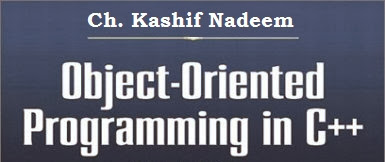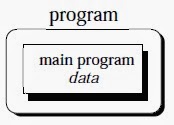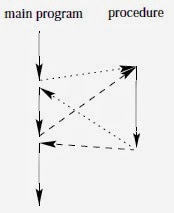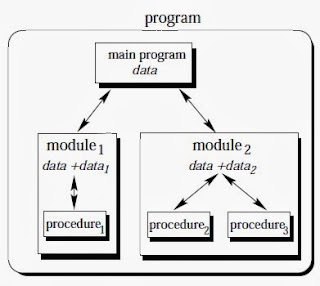Class 02 - Programming Techniques
(Object Oriented Programming)

A Survey of Programming Techniques
This
chapter is a short survey of programming techniques. We use a simple example to
illustrate the particular properties and to point out their main ideas and
problems.
Roughly
speaking, we can distinguish the following learning curve of someone who learns
program:
- Unstructured Programming
- Procedural Programming
- Modular programming
- Object Oriented Programming
Unstructured
Programming
Usually,
people start learning programming by writing small and simple programs
consisting only of one main program. Here “main
program" stands for a sequence of commands or statements which modify
data which is global throughout the whole program. We can illustrate this as
shown in Fig. 1.1

Figure 2.1:
Unstructured programming - The main program
directly operates on global data.
As
you should all know this programming technique provide tremendous disadvantages
once the program gets sufficiently large. For example, if the same statement
sequence is needed at different locations within the program, the sequence must
be copied. This has lead to the idea to extract these sequences, name them
and offering a technique to call and return from these procedures.
Procedural
Programming
With
procedural programming you are able to combine returning sequences of
statements into one single place. A procedure call is used to invoke the procedure.
After the sequence is processed, flow of control proceeds right after the
position where the call was made (Fig. 1.2).

Figure 1.2
Execution
of procedures - After processing flow of controls proceeds where the call was
made.
With
introducing parameters as well as procedures of procedures (sub procedures) programs
can now be written more structured and error free. For example, if a procedure
is correct, every time it is used it produces correct results. Consequently, in
cases of errors you can narrow your search to those laces which are not proven
to be correct.
Now
a program can be viewed as a sequence of procedure calls. The main program is
responsible to pass data to the individual calls, the data is processed y the
procedures and, once the program has finished, the resulting data is resented.
Thus, the flow of data can be illustrated as a hierarchical graph, a tree, as
shown in Fig. 1.3 for a program with no sub procedures.
Figure 1.3
Procedural programming - The main program
coordinates calls to procedures and hands over appropriate data as parameters.
To sum up: Now we have a single program which is divided
into small pieces called procedures. To enable usage of general procedures or
groups of procedures also in other programs, they must be separately available.
For that reason, modular programming allows grouping of procedures into
modules.
Structured or Modular programming
It
was introduced in 1960s. It has very best advantage to write very large
programs. In this programming approach a large program is broken down into
smaller units. In C and C++ these smaller units are called functions. In other
programming languages, the same concept may be referred to as subroutines, or sub-programs, or procedures
or modules.
With
modular programming procedures of a common functionality are grouped together
into separate modules. A program therefore no longer consists of only one
single part. It is now divided into several smaller parts which interact
through procedure calls and which form the whole program (Fig. 1.4).

Figure 1.4
Modular programming - The main program coordinates
calls to procedures in separate modules and hands over appropriate data as
parameters.
Each
module can have its own data. This allows each module to manage an internal state
which is modified by calls to procedures of this module. However, there is only
one state per module and each module exists at most once in the whole program.
In
the structured or modular programming, the logic of the program can be
expressed using three control structures, where each structure has single entry
point and a single exit point. These control structures are:
- Sequential Structure
- Conditional or Selection Structure
- Iterative or Repetitive or Loop Structure
OBJECT-ORIENTED PROGRAMMING
The
object oriented programming concept was introduced in the late1960s. But now it
has become the most popular approach to develop software. In object oriented
programming, a program in designed by using objects. We can say that the whole
program is divided into set of objects. It is an easy and very flexible
approach for designing and organizing the program. Most popular and commonly
used object-oriented programming languages are C++ and JAVA.
An
object is a component of program
that has set of functions and data structures. Every object has some properties
that s called its data members and
some functions that is called member
functions.
The
object-oriented approach is based upon the concepts of data abstraction and information
hiding. The abstraction is a tool that allows a programmer to consider a
component of software at conceptual level without knowing the detail of
implementation of component into system. An abstraction
of a component describes the external behavior of that component but does not
describe internal details of the component that produced the behavior.
Object-oriented
programming solves some of the problems just mentioned. In contrast to the
other techniques, we now have a web of interacting objects, each house-keeping
its own state (Fig. 1.5).
Figure 1.5
Object-oriented programming - Objects of the
program interact by sending messages to each other.











